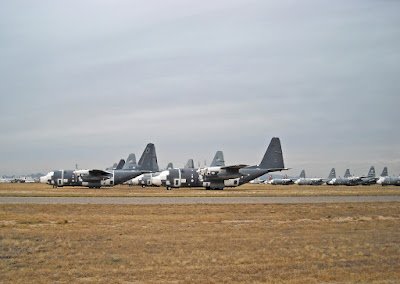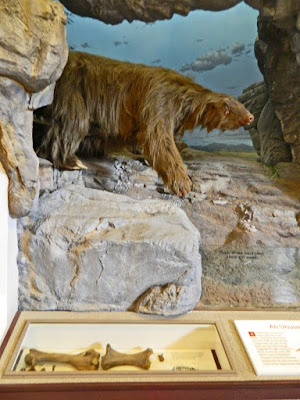Today was our sojourn to the southeast of Tucson, starting with breakfast at the iconic Gus Balon's for breakfast. Ginger went with us, leading us in her car, as we arrived soon after the place opened at 7:00.
 |
| Ginger with a cinnamon roll |
 |
| Karen and Tamiko decide to split a cinnamon roll |
Ginger recommended stopping for a photo of the "Airplane Boneyard" at the Davis-Monthan AFB, on our way down Kolb Avenue to I-10. We were the only ones to stop during the morning rush hour, but Karen got a couple pics.
 |
| Davis-Monthan AFB Airplane Boneyard, the largest in the world |
We drove east on I-10, then turned right on AZ-90 to Kartchner Caverns State Park. We had to make reservations months in advance to see fairly recently discovered (1974) wet caverns, and you had to arrive an hour early besides! Before our 10:00 tour, we had time for the Discovery Center museum, gift shop, and hummingbird garden.
 |
| Bones of and rendering of the Shasta Ground Sloth |
 |
| Boots of the discoverers, Gary Tenen and Randy Tufts; you can see boot prints in one of the cavern rooms |
 |
| Caesalpinia gilliesii/Desert Bird-of-paradise |
A wet cavern is one where the presence of water contributes to the growth of rock formations. A dry cavern is one where water is no longer present to contribute to the growth of rock formations.
We were on the Rotunda/Throne Room tour. The Big Room tour closes April 15-October 15 during the nesting season of the Myotis velifer bats. Besides the usual stalactites and stalagmites, there were columns, spires, soda straws (where the water flows inside the "straw"), drapery, cave bacon, cave popcorn, flowstone, and shields. The cave contains the world's second longest soda straw at 21 feet 3 inches, and the largest column in Arizona, called Kubla Khan, at 58 feet. The discoverers of the cave kept its founding a secret for many years, and used the code name "Xanadu" that was Kubla Khan's summer capital.
We had lunch at the Bat Cave Café, getting nice and rather gourmet sandwiches.
Next: Fairbank Ghost Town.
No comments:
Post a Comment